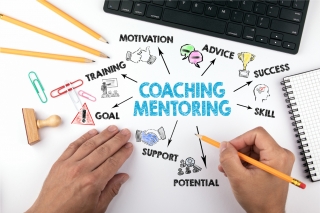
Teaching Knowledge Tactics
02 April 2024Driving the learning cycle through connection and communication.
By Warren Leigh, culinary professor, caterer, consultant and retired restaurant operator
Feedback & comments: This email address is being protected from spambots. You need JavaScript enabled to view it.
The ability to receive coaching is an important skill. Nearly all employers will tell you workers must be coachable. Being coachable leads me to the idea of the continuous learning cycle. This process begins with students, who may greatly fear a culinary classroom, learning skills, gaining confidence and becoming eager to learn more. They gain personal confidence and the ability to receive feedback. Work and learning become more efficient and the learning cycle rolls on.
Just as educators facilitate the knowledge transfer cycle to our students, our students are consistently transferring information back to us. If we are aware, students help coach us to become better educators. This connection assists in building trust and culinary skill sets which helps spin an educator’s lifelong learning cycle.
Teachers need to help culinary students believe in their newfound abilities and skill sets. We can meet new learners where they are on the learning cycle. We can shape new ways to communicate while realizing not all students receive information or coaching the same way. We can find a vocabulary that works for us and the students.
The tactics of teaching knowledge
Establishing that educators and students are on the same team in this transfer of knowledge process begins on the first day of class and lasts through the last exam.
Getting to know students from day one is among the first opportunities to successfully participate in the knowledge exchange process. I ask each student to share something no one knows about them or any workplace experience that might shed light on topics we will cover. While fun (and perhaps awkward), this begins an open conversation and puts people at ease. It also allows me to understand students’ unique insights and experiences. I see them where they are on the learning cycle.
I use everyday class tactics to activate and continue the learning cycle. I begin class with a visit to each student to see if they have any questions from previous classes, making sure not to single out individuals. For those less likely to openly participate, I also use an online document for students to record their thoughts and challenges. This quick formative assessment allows students to share and connect with me. I can adapt my instruction to answer and build upon their questions to facilitate a deeper understanding of culinary concepts. This is an example of students providing feedback or coaching to me.
I also use a lab journal/production document for students to plan for their lab, add notes, and reflect upon the completed lesson. These assignments illustrate students’ position within the learning process.
Another tactic I openly discuss is criticism and how we can learn from it as a group. I might say something like, “Let’s see how this got overcooked and how we can avoid it moving forward.” It takes a few classes, but students eventually learn that critique will happen and they must learn to receive it.
I also open the knowledge exchange to include older students who can mentor newer students or operate as a supplemental instructor, which is especially helpful during a lab. Using the information I’ve collected from my students, I ask myself, “Did learning occur or will it occur with more time?” This feedback informs my future lesson planning.
Overall, educators must teach to the people in front of them. Each student is unique with a different learning style. Sometimes we must try many ways of connecting and transferring ideas and knowledge. As I mentioned in a previous article, “Better Teaching Skills: Engaging in the Transfer of Knowledge,” I taught a visually impaired skier. Through trial and error, we discovered that sound was an effective instruction tool in the world of skiing. I then successfully applied the same auditory teaching tactic in my knife skills lesson. This experience helped me become a better facilitator of learning and I adapted to my learner’s needs.
A student’s role
I often tell students they are likely going to see, read and hear things much differently than I do. I invite them to share their views and questions. They are reminded that if one person has questions then someone else in the class likely does too. I often tell students that they will be presented with various concepts in numerous ways as I try and connect with all learners. A student’s role is to collect all the different ways I present information, sift through them, and figure out which way makes the most sense to them.
Ultimately, students and educators must be open to learning and receiving feedback from one another. When this successfully occurs, it is gratifying. I recently received a note from a previous ski student. One sentence hit my heart: “If you take away one thing from this (ski) season, I want you to know that you have changed my life for the better.” This is the reason we teach.
